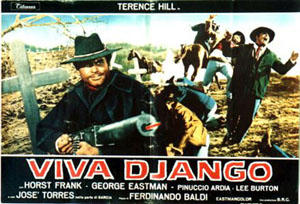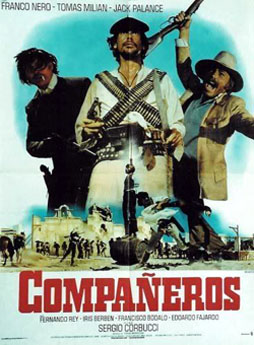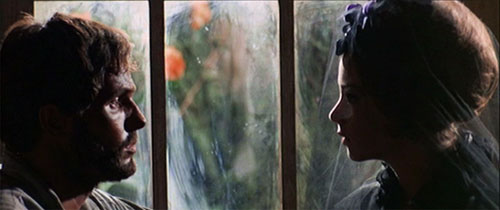“This short cigar belongs to a man with no name. This long gun belongs to a man with no name. This poncho belongs to a man with no name. He's going to trigger a whole new style in adventure.” And with that the Spaghetti Western was born.
Hitting Italian screens in 1964, Sergio Leone’s A Fistful of Dollars bought a huge change to the way westerns looked, sounded and were regarded. Clint Eastwood’s character with no name (who was actually called Joe) brought with him a new edge that the counter culture generation could relate to. He wasn’t the John Wayne hero in a white hat shooting down black hats; he was an ambiguous character flirting with the lines of good and bad,  more interested in cash than honor. Leone found American westerns to be too slow; people talked too much and there wasn’t nearly enough action, so with that in mind he set out to make fairytales for adults... gritty, violent and loud fairytales. However Leone was far from the only man working in the genre, between 1964 and 1973 over 500 Italian westerns were produced. The gold rush began and characters such as Django, Trinity and Sartana quickly entered European popular culture.
more interested in cash than honor. Leone found American westerns to be too slow; people talked too much and there wasn’t nearly enough action, so with that in mind he set out to make fairytales for adults... gritty, violent and loud fairytales. However Leone was far from the only man working in the genre, between 1964 and 1973 over 500 Italian westerns were produced. The gold rush began and characters such as Django, Trinity and Sartana quickly entered European popular culture.
A Fistful of Dollars however was not the first European western, examples can be traced all the way back to the 1900s, one example even starring Sergio Leone’s own mother and another in the 1920s with Bela Lugosi. There was also the German produced Winetou series that had been a big success two years before Leone’s film hit the scene. What is meant by the term Spaghetti Western is not simply the fact that the film was shot in Europe; it’s about the style, the violence, the anti heroes and the dirt. The term originated from derogatory reviews published by American critics who used the term to mark the films out as inauthentic and cheap. But nobody could tell the Europeans that, they couldn’t care less what the Americans had to say about their new genre, going to the cinema in droves to see the films, helping some of them earn up to 4 billion lire. The trend started by Fistful lasted all the way up until the late 70s, with roughly 60 Italian Westerns being produced each year between 1965 and 1968.
A Fistful of Dollars spawned many copycats in its first year but come 1966 Leone was far from the only influential name in town. Unique films such as Sergio Corbucci’s Django broke out; a film so popular that it spawned over 50 in name only sequels (some through re-titling for foreign markets). The name Sergio Corbucci is synonymous with Spaghetti Westerns to many cult film fans. Not only did he direct Django, but the Burt Reynolds starring Navajo Joe, political action extravaganza The Mercenary and last but certainly not least, The Great Silence, a film regarded by many fans as the greatest Spaghetti Western ever made. The success of Django’s unique approach allowed other directors to move away from the template set by Leone and opened up a whole new direction and sense of freedom for the genre. A director equally as interesting as Corbucci was Sergio Sollima, a man who like many was forced in to the western genre yet managed to find a way to convey his own ideology and carve out a niche for himself.  His film Face to Face starring Gian Maria Volonte and Tomas Milian is part of the political Spaghetti Western wave that had started with Damiano Damiani’s A Bullet for the General. The films usually feature Mexican peons thrown in to the world of revolutions by an outside influence (a wave Leone did a take on with Duck, You Sucker a few years later). Antonio Margheriti, a director better known for his gothic horror films even got the chance to make a horror western shot almost entirely at night called And God Said to Cain. Although there were those out there that were ripping off Leone, directors such as Corbucci, Sollima, Baldi and Damiani managed to put their own stamp on the genre; and unlike Leone were not fans of the American westerns that he so wished to pay tribute to, pushing the Spaghetti Western to a whole new level.
His film Face to Face starring Gian Maria Volonte and Tomas Milian is part of the political Spaghetti Western wave that had started with Damiano Damiani’s A Bullet for the General. The films usually feature Mexican peons thrown in to the world of revolutions by an outside influence (a wave Leone did a take on with Duck, You Sucker a few years later). Antonio Margheriti, a director better known for his gothic horror films even got the chance to make a horror western shot almost entirely at night called And God Said to Cain. Although there were those out there that were ripping off Leone, directors such as Corbucci, Sollima, Baldi and Damiani managed to put their own stamp on the genre; and unlike Leone were not fans of the American westerns that he so wished to pay tribute to, pushing the Spaghetti Western to a whole new level.
The success of films such as Django and A Pistol for Ringo showed European producers that American leads were no longer needed to make a successful western. Actors such as Franco Nero and Giuliano Gemma became such a huge draw in Europe that the American stars of the 1965 Spaghetti westerns such as Mark Damon seemed far less necessary. By 1966 it became apparent that Italians enjoyed seeing themselves on screen and the use of Americanized pseudonyms (Giuliano Gemma was billed as Montgomery Wood in the 1965 Ringo films) also began to fall out of use as the country embraced the genre as their own. European stars also began carving out their own character types moving away from the archetypal Clint Eastwood stranger. Eventually Django star Franco Nero no longer even had to play Americans, often turning up as Swedish, Polish or Russian characters. Mexican characters also began to lead films, such as those played by Cuban actor Tomas Milian in the films of Sergio Sollima and others such as Tepepa. That’s not to say that suddenly every western contained no Americans, but it goes to show how far the Italians had come with the genre. Due to most of the films being co productions actors of all nationality showed up in the films. Actors such as Klaus Kinski regularly tuned up in them to please German investors, Fernando Sancho to please the Spanish and so on. By 1968 nearly 50% of Italian film crews were off making westerns.
By 1970 however profits were dwindling and a shot in the arm to the genre was given by something that sounds the death knell for any genre… and that was revitalization through parody. Once the slap stick goofball approach of My Name Is Trinity hit the theaters in 1970 there was no way back to the golden age. In a short amount of time the movie grossed three times as much as For A Few Dollars More making it not only the most successful Spaghetti Western, but also the most successful Italian movie ever made up to that point. Attempts were made to revive the genre in the late 1970s with ‘twilight westerns’ such as Keoma and Mannaja, but aside from the one off success of Enzo G. Castellari’s Keoma they failed to restore interest in the Italian western. The twilight westerns were filmed on the abandoned, decaying sets that had been so popular in previous decade, with an extreme use of dust and fog to hide the damage. The films had a lot in common with Django in their approach, but by that point Italian interests had long since shifted towards the contemporary set genres of the giallo and poliziotteschi.

The end of the Spaghetti Western was bittersweet. Although the genre died out around 1972 many of the genre’s directors and stars found new life in the poliziotteschi genre, which was more or less the an extension of the serious Spaghetti Westerns only in a contemporary setting. Some of the directors such as Enzo G. Castellari, if anything, produced better films in this genre than they did Westerns. Unfortunately Spaghetti Westerns are criminally under represented on DVD, with many of the genre’s best films (such as The Mercenary, The Big Gundown, and Return of Ringo) still unavailable in the US or UK.

